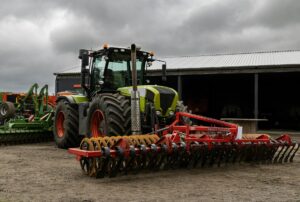The John Deere 4020 is more than just a tractor—it’s an icon in agricultural history. Introduced in the 1960s, this workhorse helped revolutionize modern farming and continues to be a favorite among collectors and farmers alike. In this article, we’ll explore everything you need to know about the John Deere 4020: from its history and specifications to its lasting legacy and tips for maintenance and restoration.
History of the John Deere 4020
The John Deere 4020 was first introduced in 1963 as part of John Deere’s New Generation Series. It replaced the 4010 model, bringing with it a series of improvements that would set new standards in the farming industry.
What Made the John Deere 4020 Special?
One of the key reasons the John Deere 4020 became so popular was its versatility. Whether used for plowing, planting, harvesting, or general hauling, the 4020 delivered reliable performance across the board. It quickly became the best-selling tractor of its time, with over 184,000 units produced between 1963 and 1972.
John Deere 4020 Specifications
Understanding the specs of the John Deere 4020 helps us appreciate why it was such a game-changer. Here are some of its most notable features:
Engine Options
- Diesel Engine: 6-cylinder, 404 cubic inches
- Gasoline Engine: 6-cylinder, 362 cubic inches
- LP Gas Engine: Alternative fuel option
Power Output
- PTO (Power Take-Off): Approx. 95 horsepower
- Drawbar: Approx. 84 horsepower
Transmission
- Synchro-Range Transmission: 8 forward, 2 reverse gears
- Power Shift Option: Popular for ease of use
Hydraulics and 3-Point Hitch
- Closed-center hydraulic system
- Category II 3-point hitch
- Excellent lifting capacity and hydraulic control
Dimensions and Weight
- Weight: Approx. 9,000 lbs (with ballast)
- Wheelbase: 100.3 inches
- Length: 152.5 inches
These specs made the John Deere 4020 a powerful and reliable machine for a wide range of farming tasks.
Popular Features and Upgrades
The 4020 was one of the first tractors to offer optional factory-installed cabs for added operator comfort. It also included power steering, a differential lock, and hydraulic power brakes—all of which were considered advanced at the time.
Many farmers upgraded their John Deere 4020 tractors over the years with modern features like:
- Roll-over protection structures (ROPS)
- Air conditioning systems
- LED lighting kits
- GPS navigation for precision farming
Why the John Deere 4020 is Still Popular Today
Even decades after production ended in 1972, the John Deere 4020 is still widely used and loved. Here’s why:
1. Reliability and Durability
This tractor was built to last. Many units are still in working condition on farms around the world today, with minimal repair needed even after 50+ years.
2. Ease of Maintenance
Compared to modern tractors filled with electronic components, the 4020 is easy to service. Parts are still widely available, and many farmers appreciate the simplicity of its design.
3. Resale and Collector Value
Because of its iconic status, the John Deere 4020 holds its value well. Restored units can fetch prices upwards of $15,000 to $30,000 at auction, depending on condition and originality.
4. Versatility
Whether you’re plowing, mowing, or hauling, the John Deere 4020 can handle the job. It was, and still is, a truly multi-purpose machine.
Tips for Maintaining a John Deere 4020
If you’re lucky enough to own a John Deere 4020, keeping it in top shape is crucial. Here are a few tips to help extend its life:
Regular Maintenance Checklist
- Oil Changes: Every 100 hours of operation
- Hydraulic Fluid Check: Every 50 hours
- Air Filter Replacement: Clean or replace based on dust conditions
- Fuel Filter Change: Every 200 hours
- Tire Pressure Monitoring: Especially important if you’re using it in the field
Watch for Common Issues
While the 4020 is reliable, a few issues can pop up over time:
- Hydraulic pump wear or leakage
- Worn-out seals on the power steering
- Electrical issues with the lights and gauges
Use Quality Replacement Parts
Always choose OEM (Original Equipment Manufacturer) or high-quality aftermarket parts to ensure longevity and compatibility.
John Deere 4020 Restoration: What You Need to Know
Restoring a John Deere 4020 can be a rewarding project for both farmers and tractor enthusiasts. Whether you’re aiming for a full frame-off restoration or just a mechanical refresh, here are a few steps to follow:
Step 1: Evaluation
Start by assessing the condition of your tractor. Look for signs of:
- Engine wear
- Frame rust
- Hydraulic leaks
- Electrical problems
Step 2: Parts Sourcing
Make a list of all parts you need. Popular sources include:
- John Deere dealerships
- Online marketplaces like eBay
- Tractor salvage yards
- Specialized vintage tractor parts websites
Step 3: Disassembly and Repair
Take your time during disassembly. Document everything with photos so reassembly goes smoothly.
Step 4: Paint and Decals
Use authentic John Deere green and yellow paint for best results. Don’t forget the official John Deere decals for a showroom finish.
Step 5: Reassembly and Testing
Once the tractor is rebuilt, test every function carefully. Check PTO, hydraulics, transmission, and brakes before putting it back to work or on display.
Fun Facts About the John Deere 4020
- The 4020 was the most popular tractor of its generation.
- Many 4020 tractors are still used in parades, shows, and antique tractor pulls.
- The tractor inspired numerous scaled-down toy versions, which are collector’s items today.
- John Deere offered special edition versions and industrial models of the 4020 for heavy-duty applications.
Buying a Used John Deere 4020: What to Look For
If you’re in the market for a used John Deere 4020, consider the following:
Inspection Checklist
- Check for visible signs of oil or hydraulic fluid leaks.
- Inspect the tires and rims for wear or cracks.
- Run the engine and listen for unusual noises.
- Test the transmission and PTO.
- Look for authenticity: serial number, decals, and original paint condition.
Pricing Guide (As of 2025)
- Non-running or project tractors: $3,000–$6,000
- Functional but unrestored: $7,000–$15,000
- Fully restored and collectible: $20,000–$35,000+
Final Thoughts: The Legacy of the John Deere 4020
The John Deere 4020 isn’t just a tractor—it’s a piece of agricultural history. Whether you’re a farmer looking for a dependable machine, a collector hunting for a classic, or someone who appreciates vintage machinery, the 4020 stands the test of time.
Its rugged design, powerful performance, and rich legacy make it one of the most celebrated tractors in the world. For many, owning a John Deere 4020 is not just about functionality—it’s about preserving a legacy that helped build modern agriculture.
FAQs About the John Deere 4020
Q: When was the John Deere 4020 made? A: It was produced from 1963 to 1972.
Q: What engine is in the John Deere 4020? A: It came with diesel, gasoline, or LP gas engines. The diesel engine was the most popular.
Q: Is the John Deere 4020 still a good tractor today? A: Absolutely. It remains highly valued for its durability, simplicity, and power.
Q: Where can I buy parts for the John Deere 4020? A: Parts are available at John Deere dealerships, online marketplaces, and tractor salvage yards.
Q: How much does a restored John Deere 4020 cost? A: Depending on the condition, restored units can range from $20,000 to over $30,000.



